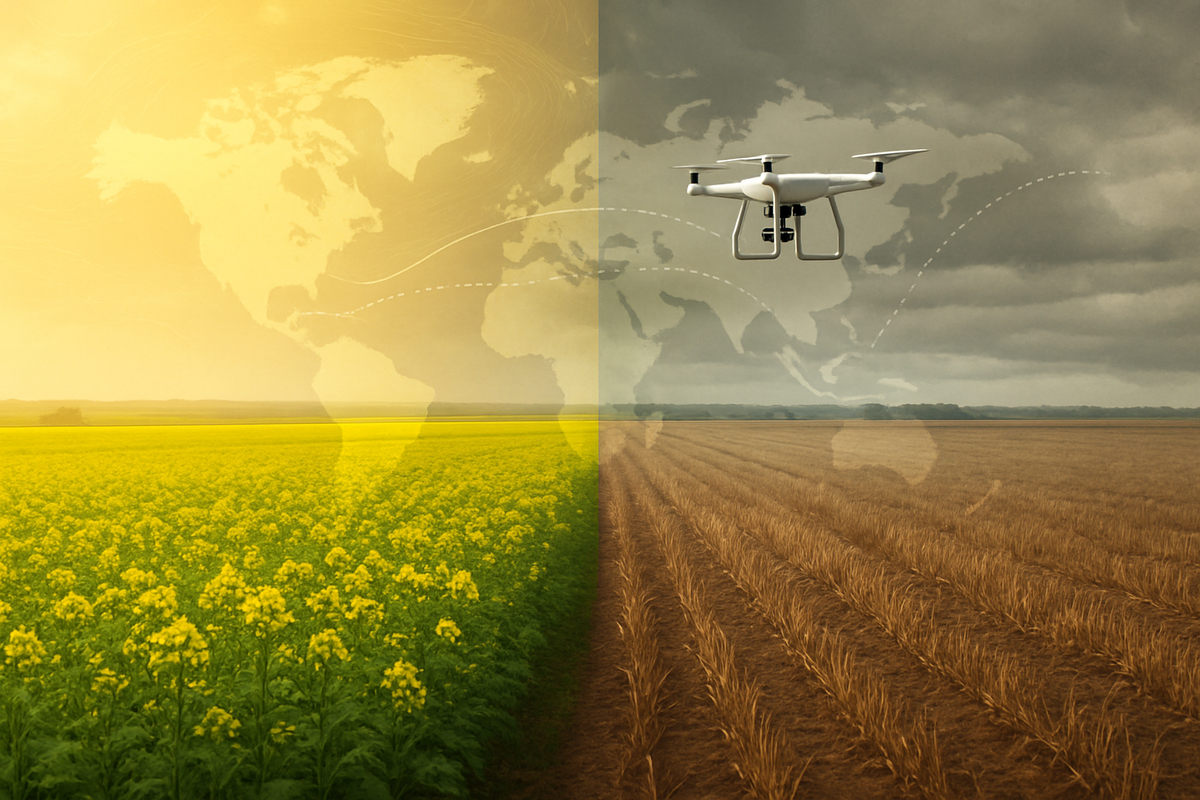
Calgary, Alberta – October 14, 2025 – Global agricultural commodity markets are exhibiting a bifurcated trend, with Canola futures demonstrating a degree of resilience and modest gains, while various wheat futures, particularly Minneapolis and Kansas City varieties, have recently experienced significant downward pressure, even hitting five-year lows. This divergence, as highlighted by recent commodity reports, signals a complex interplay of environmental, geopolitical, and supply-demand factors that are reshaping the financial landscape for producers, processors, and consumers worldwide. The immediate implications point to potential profitability for some segments of the oilseed market, particularly those benefiting from strong crushing margins and biofuel demand, contrasted with considerable financial strain for wheat farmers grappling with oversupply and high input costs.
The mixed signals in these crucial agricultural staples underscore a period of heightened volatility and uncertainty, challenging traditional market assumptions and demanding agile responses from all stakeholders. While Canola's modest upticks on the ICE Futures exchange, with November and January contracts showing gains as of October 14, 2025, offer a glimmer of optimism, the persistent decline in wheat prices casts a long shadow over the broader grain sector, signaling a tough harvest season for many.
Unpacking the Price Divergence: A Tale of Two Commodities
The recent movements in agricultural futures paint a detailed picture of contrasting fortunes. Canola futures have experienced notable volatility but also periods of strong upward momentum throughout 2025. In May 2025, prices surged to C$722.70 per metric ton (MT), with July canola futures on the ICE Futures exchange rising by 10.7% in the month prior to May 2, 2025. This surge was attributed to increased demand. While Canadian canola futures had seen a monthly decline of 3.35% by October 14, 2025, they remained 2.31% higher than a year ago, closing at $615.00 per tonne for November delivery and $628.10 for January. This resilience, in part, stems from stronger performances in related markets and optimism surrounding thawing trade relations with China, which could potentially see the removal of punitive tariffs.
In stark contrast, Minneapolis Wheat and Kansas City Wheat futures have largely been on a downward trajectory, with recent periods of decline counteracting earlier, intermittent rallies. Despite a brief "skyrocket" in Chicago wheat futures in February 2024 (reported February 2025) due to Black Sea frost fears, and a sharp rise in U.S. wheat prices in June 2025 due to short-covering, the overall trend has been bearish. By October 7, 2025, both Minneapolis and Kansas City wheat contracts "continued their downward trajectory," primarily due to persistent concerns of abundant global supplies and a critical lack of fresh data exacerbated by an ongoing U.S. government shutdown. On October 14, 2025, U.S. wheat markets were generally losing 1 to 4 cents, hitting contract and five-year lows, though intraday trading saw some recovery. Overall, wheat prices on this date were down 4.71% over the past month and a significant 13.68% compared to a year ago.
Several key factors are contributing to these divergent and volatile price movements. Weather conditions remain a primary driver, with dryness in Russia, Ukraine, and parts of the U.S. causing uncertainty, while excessive moisture affected the winter wheat harvest in Kansas and Oklahoma in June 2025. Supply and demand dynamics are also critical. For Canola, robust exports and tightening carryout stocks earlier in the year contributed to surges, though the global market in 2025 has also grappled with oversupply from strong harvests in Canada, Australia, and Russia. Long-term optimism for canola is buoyed by increasing demand from the biofuel sector. For Wheat, while global production for 2024-25 was forecasted to increase slightly, by October 2025, a "problem of plenty" emerged, with robust overall supply levels and increased Russian exports contributing to lower prices.
Geopolitical events continue to cast a long shadow. The Russia-Ukraine conflict influences wheat availability, and Russia's impending export quotas (as of February 2025) were expected to slow Black Sea shipments. Trade policies also play a significant role; U.S. biofuel policies in January 2025 disadvantaged biofuels made from soybean and canola oil, while China's punitive tariffs on Canadian canola have fragmented the market. However, recent optimism about thawing U.S.-China trade relations and potential removal of Canadian canola tariffs could significantly impact canola prices. Lastly, market sentiment and macroeconomic trends, including speculative trading, a weaker U.S. dollar, and rising crude oil prices, all contribute to the complex pricing environment.
Corporate Fortunes: Winners and Losers in the Agricultural Divide
The current commodity price landscape presents a mixed bag for public companies across the agricultural value chain. The diverging trends in canola and wheat futures mean that some companies are poised for gains, while others face significant headwinds.
Agricultural Processors and Traders stand to benefit from the current market dynamics, particularly those with diversified portfolios and strong risk management strategies. Companies like Archer-Daniels-Midland Company (NYSE: ADM) and Bunge Global SA (NYSE: BG) are major players in both oilseed processing and grain milling. While lower wheat prices directly reduce their input costs for flour and other grain products, potentially expanding profit margins, their oilseed segments could also see improved revenues from higher selling prices for canola oil and meal, especially if crushing margins remain favorable. Bunge's recent merger with Viterra further solidifies its market position, allowing it to navigate these fluctuations more effectively. Similarly, AAK AB, a global leader in plant-based oils and fats with canola oil comprising 13% of its portfolio, reported strong operating profit growth in Q2 2025, suggesting an ability to manage input costs despite volume changes.
The Biofuel Sector also emerges as a potential winner from the long-term demand for canola. As canola oil can substitute for soybean oil in renewable diesel production, companies involved in bio-based products could see increased demand for canola as a feedstock, boosting their related segments.
Conversely, Agricultural Producers (Farmers), particularly wheat growers, are facing significant financial strain. The combination of low wheat prices—hitting five-year lows—and persistently high input costs for fertilizers, seeds, and fuel is squeezing profit margins, pushing many farmers to operate at a loss. This "paradox of plenty," where abundant harvests depress prices, is a severe challenge for companies like Adecoagro (NYSE: AGRO), which operates farming businesses including wheat production, directly impacting their revenues.
The financial difficulties of farmers have a ripple effect on Agricultural Input Suppliers. Companies providing seeds, fertilizers, crop protection products, and farm equipment are likely to suffer as financially stressed farmers reduce spending and delay investments. This could negatively impact major players such as Deere & Co. (NYSE: DE), a leading agricultural machinery manufacturer, facing reduced demand for new equipment. Similarly, Corteva, Inc. (NYSE: CTVA), a major provider of seeds and crop protection, and Nutrien Ltd. (NYSE: NTR), the world's largest provider of crop inputs, could experience pressure on sales and pricing power as farmers cut back on input purchases.
Consumer Food Manufacturers that heavily rely on wheat flour as a primary ingredient, such as bakers, packaged food companies, and restaurants, could see some relief from declining wheat prices, potentially improving their profit margins. However, those heavily dependent on canola oil could face increased raw material costs if canola prices continue their upward trend, unless they can effectively pass these costs onto consumers. Overall, companies with robust risk management strategies, diversified operations, and the ability to adapt their pricing will be best positioned to navigate this volatile environment.
Wider Implications: A Shifting Landscape for Global Food Security
The current price dynamics in canola and wheat futures are not isolated incidents but rather integral components of broader industry trends in agricultural markets, carrying significant ripple effects across the global food supply chain and prompting critical regulatory and policy considerations.
The consistent geopolitical conflict, particularly the Russia-Ukraine war, has profoundly impacted wheat markets since February 2022, causing supply disruptions from the Black Sea region and exacerbating existing challenges. This aligns with a broader trend of rising input costs, where escalating fertilizer and energy prices directly inflate production costs for crops like wheat. While global demand for wheat has steadily increased over the past decade due to population growth, the current "problem of plenty" in some regions, notably the U.S., illustrates the market's struggle to balance robust supply with effective distribution. For canola, biofuel demand remains a strong long-term driver, linking its prices to crude oil fluctuations, while trade tariffs, such as China's duties on Canadian canola, continue to fragment markets and reroute trade flows.
These price movements create substantial ripple effects. For competitors, countries with strong harvests or alternative export capabilities can gain market share during periods of high prices or supply disruptions from major exporters. Conversely, partners like food processors, livestock producers, and food manufacturers face increased input costs, often passed on to consumers, or face squeezed profit margins. This drives a need for supply chain diversification and investment in technology to improve efficiency. Most critically, the global food supply chain faces heightened risks of food insecurity, particularly in low-income and import-dependent developing countries, where rising prices make food less accessible. This can lead to inflationary pressures and social unrest, echoing the 2007-2008 Food Crisis and the 2010-2011 food price hikes that contributed to the Arab Spring. These historical precedents, along with events like the 2012 US Drought, demonstrate that agricultural commodity price spikes typically result from a confluence of adverse weather, high energy costs, increased biofuel demand, supply disruptions, and trade policies.
In terms of regulatory and policy implications, the market volatility highlights the need for more robust government support and safety nets for the agricultural sector. Discussions around trade policy reform will intensify, aiming to protect domestic producers while ensuring global food security. There's also growing concern over financial speculation in commodity markets, with calls for reforms to manage price volatility. Furthermore, environmental policies and the impact of climate change on agriculture necessitate strategic policy design and financial support for sustainable farming practices. The U.S. government shutdown in early October 2025 underscored the importance of data transparency, as the halt in releasing crucial agricultural data exacerbated market uncertainty. The interconnectedness of these factors means that policy decisions in one area can have far-reaching consequences across the entire global agricultural landscape.
Navigating the Future: Adaptations and Opportunities Ahead
The path forward for canola and wheat futures markets is characterized by continued dynamism, requiring strategic pivots and adaptations from all participants. Both short-term and long-term possibilities are heavily influenced by a confluence of supply-demand dynamics, geopolitical shifts, and climate variability.
In the short-term (coming months – 2025), canola futures are expected to experience volatility, with potential bearish pressures stemming from projected oversupply from strong harvests in 2024/25, which could spill into the 2025/26 marketing year. China's ongoing anti-dumping investigation and tariffs on Canadian canola oil and meal (effective March 2025) remain significant headwinds, potentially redirecting Canadian exports and pressuring prices in other markets like the EU. However, strong export activity and high domestic processing demand, coupled with long-term biofuel demand, offer some price support. For wheat, short-term volatility is also expected, with prices potentially remaining elevated (forecasted $6.50-$7.50 per bushel) due to global supply chain constraints and continued demand for U.S. wheat. Geopolitical factors, particularly the Russia-Ukraine conflict and Russia's export quotas, will continue to drive price fluctuations, alongside unpredictable weather patterns in major producing regions.
Looking at the long-term (2025-2026 and beyond), the fundamentals for canola remain compelling. The global canola seed market is projected for significant growth, driven by increasing demand for biofuels and health-conscious consumer trends. Regulatory tailwinds from clean fuel standards in the U.S. and Canada are expected to expand its role as a biofuel feedstock. However, the full impact of China's trade policies could lead to lower Canadian exports and higher stocks, potentially depressing prices. For wheat, global production is forecast at a record high in 2025, with bumper crops expected from major producers. While this increased supply could lead to lower long-term prices, global consumption is also projected to reach record levels, maintaining a delicate balance. Rising production costs and the increasing impact of climate change will continue to introduce volatility and challenge long-term stability.
Strategic pivots and adaptations are crucial for market participants. Risk management and hedging through agricultural futures trading, options strategies, and crop insurance will be essential for farmers and agribusinesses to mitigate price volatility. Building supply chain resilience and diversification is paramount, involving exploring new export markets for Canadian canola beyond China and understanding global trade flows for wheat. Data analytics and technology adoption, including AI, IoT, and precision agriculture, will be critical for predicting market movements, optimizing yields, and making informed decisions. Farmers must also prioritize adaptation to climate change by developing resilient crop varieties and farming practices. Lastly, closely monitoring government policies and trade agreements will be vital, as changes in biofuel mandates, subsidies, and tariffs can significantly impact commodity markets.
Emerging market opportunities include the continued growth of biofuel demand for canola, the agritech revolution offering increased efficiency and transparency, and health-conscious consumer trends driving demand for healthy oils. However, significant challenges persist, including ongoing geopolitical instability, the escalating impact of climate change on yields, potential oversupply from record harvests, rising input costs, and the threat of trade protectionism.
Conclusion: Navigating a New Era of Agricultural Volatility
The agricultural commodity markets for canola and wheat are currently navigating a period of profound transformation, marked by a delicate balance of growth drivers and significant challenges. The recent divergence in price trends—canola's resilience amidst wheat's decline—underscores the complex and interconnected nature of global food systems, demanding heightened awareness and strategic agility from all stakeholders.
Key takeaways from this analysis highlight that volatility is the new norm for both markets, driven by unpredictable weather, geopolitical tensions, and shifting trade policies. Canola faces short-term bearish pressures from potential oversupply and trade disputes but benefits from strong long-term fundamentals fueled by biofuel and health-conscious consumer demand. Wheat, on the other hand, is walking a tightrope between robust global demand and forecasts for record production, all while grappling with persistent climate-related disruptions and geopolitical constraints on exports. Crucially, the integration of advanced agricultural technologies, from AI to precision farming, is becoming an imperative for optimizing production, enhancing efficiency, and building resilient supply chains.
Moving forward, the market will continue to be shaped by critical external factors. Investors should watch for:
- Weather patterns in major producing regions, as these directly impact yield expectations.
- Geopolitical developments, particularly in the Black Sea region and U.S.-China trade relations, which can significantly alter supply dynamics and price premiums.
- Government policies and biofuel mandates from major agricultural nations, as these can significantly shift demand and supply dynamics.
- Monthly supply and demand reports from agencies like USDA and AAFC, which provide critical forecasts for production, exports, and stocks.
- Currency fluctuations (e.g., Canadian and U.S. dollars), affecting export competitiveness.
- Global oilseed complex dynamics for canola, as substitution effects with soybeans and palm oil are strong.
- Rising input costs for fertilizers and fuel, which continue to influence production decisions and overall commodity prices.
In essence, the agricultural market is moving into a new era where adaptability, technological adoption, and robust risk management will be paramount. While short-term corrections might offer strategic entry points for investors in canola, those in wheat must carefully weigh record production forecasts against enduring geopolitical risks and demand. The lasting impact of current events will be defined by how effectively the industry can harmonize global supply with demand, mitigate environmental risks, and navigate the intricate web of international trade and politics.
This content is intended for informational purposes only and is not financial advice





